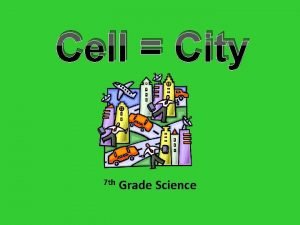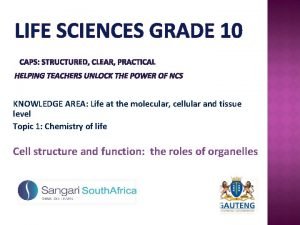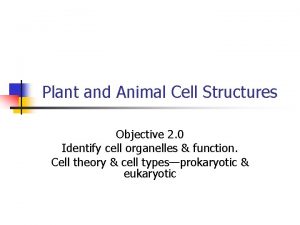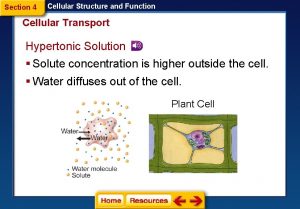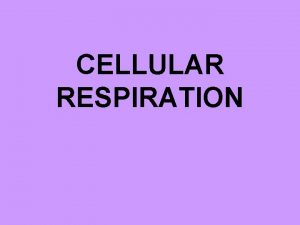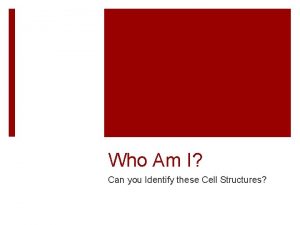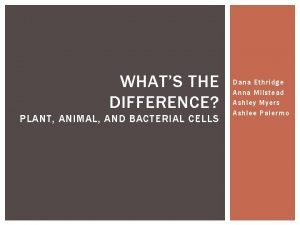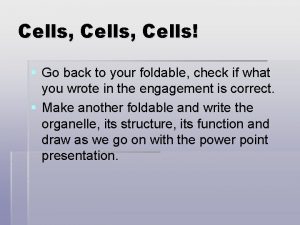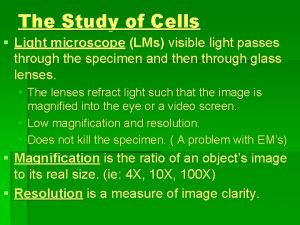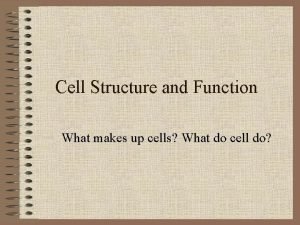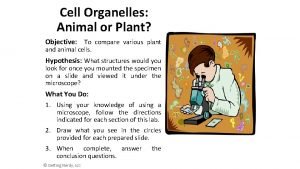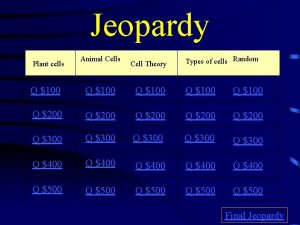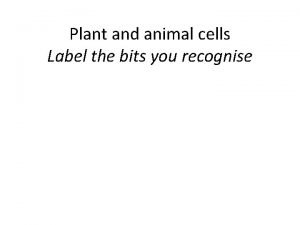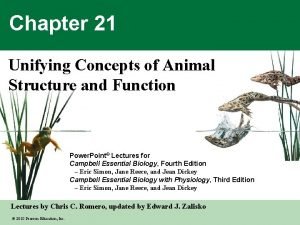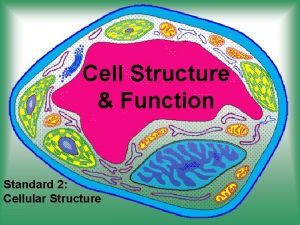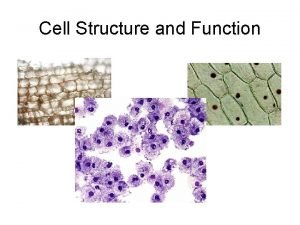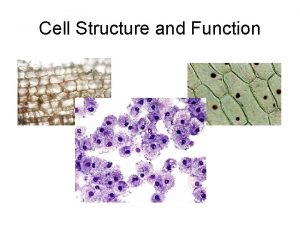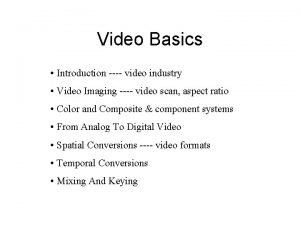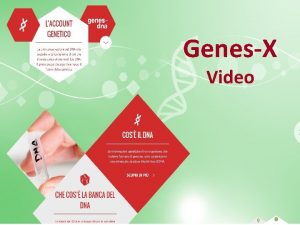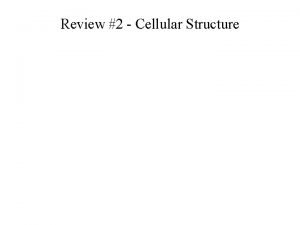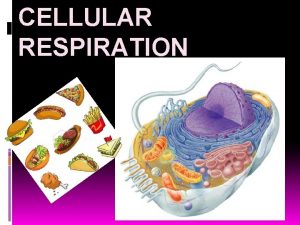Animal Cell Structures Cell Video Cellular Structure and




































- Slides: 36


Animal Cell Structures

Cell Video

Cellular Structure and Function The Plasma Membrane § Thin, flexible boundary between the cell and its environment § Allows nutrients into the cell § Allows waste to leave the cell

Cellular Structure and Function The Plasma Membrane Selective Permeability § The plasma membrane controls the movement of substances into and out of the cell.

Cellular Structure and Function The Plasma Membrane § The plasma membrane is composed of the phospholipid bilayer. § A phospholipid molecule is composed of a polar head (phosphate group) and two non-polar tails (fatty acids).

Cellular Structure and Function The Plasma Membrane Fluid Mosaic Model § The phospholipid bilayer allows other molecules to “float” in the membrane. Other Components § Proteins § Cholesterol § Carbohydrates

Cellular Structure and Function The Plasma Membrane Proteins § Transmit signals inside the cell § Act as a support structure § Provide pathways for substances to enter and leave

Cellular Structure and Function The Plasma Membrane Cholesterol § Prevents fatty acid tails from sticking together



Cellular Structure and Function Cellular Transport Hypotonic Solution § Solute concentration is higher inside the cell. § Water diffuses into the cell. Plant Cell Blood Cell 13, 000 x


The Cytoplasm § Cytoplasm: semifluid material in the cell.

§ Cytoskeleton: a supporting § Nucleus & Nucleolus: network of long, thin protein nucleus directs the cells fibers that for a framework processes & the for the cell & provide and nucleolus makes anchor for organelles ribosomes.

§ Vacuole: a place of temporary storage for materials. § Ribosome: help manufacture proteins.

§ Mitochondria: a membrane-bound organelle that makes energy available to the rest of the cell. § Golgi Apparatus (Golgi Body): A flattened stack of tubular membranes that modifies proteins and packages them for distribution outside the cell.

Endoplasmic Reticulum § A highly folded membrane that is the site of protein synthesis. § Rough ER – makes proteins § Smooth ER – makes lipids

§ Centriole: organelles that occur in pairs and are important in cell division. § Lysosome: a vesicle that contains digestive enzymes for the breakdown of excess or warn out cellular substances.

Cilia: short, hair-like projections from the cell’s surface to aid in movement § Flagella: long, tail-like projections that use whiplike motion that helps the cell move

Cellular Reproduction Cellular Growth The Cell Cycle § Cell division prevents the cell from becoming too large. § It also is the way the cell reproduces so that you grow and heal certain injuries. § Cells reproduce by a cycle of growing and dividing called the cell cycle.

Cellular Reproduction Cellular Growth § Interphase is the stage during which the cell grows, carries out cellular functions, and replicates.

Cellular Reproduction Cellular Growth § Mitosis is the stage of the cell cycle during which the cell’s nucleus and nuclear material divide. § Cytokinesis is the method by which a cell’s cytoplasm divides, creating a new cell. The new cells are called Daughter Cells.

Stages of Mitosis

Cellular Growth

Cellular Reproduction Cell Cycle Regulation Abnormal Cell Cycle: Cancer § Cancer is the uncontrolled growth and division of cells. § Cancer cells can kill an organism by crowding out normal cells, resulting in the loss of tissue function.

Cellular Reproduction Cell Cycle Regulation Causes of Cancer § Various environmental factors can affect the occurrence of cancer cells. A number of environmental factors cause DNA mutations that can lead to cancer: toxins in cigarette smoke, sunlight and other radiation, and some viruses. 6: 21

Cellular Reproduction Cell Cycle Regulation Apoptosis § Programmed cell death § Cells going through apoptosis actually shrink and shrivel in a controlled process. When a cell undergoes apoptosis, white blood cells called macrophages consume cell debris.

Cellular Reproduction Cell Cycle Regulation Stem Cells § Unspecialized cells that can develop into specialized cells when under the right conditions

Cellular Reproduction Cell Cycle Regulation Embryonic Stem Cells § After fertilization, the resulting mass of cells divides repeatedly until there about 100– 150 cells. These cells have not become specialized.

Cellular Reproduction Cell Cycle Regulation Adult Stem Cells § Found in various tissues in the body and might be used to maintain and repair the same kind of tissue § Less controversial because the adult stem cells can be obtained with the consent of their donor

Macromolecules § - large molecules that are formed by joining smaller molecules together. § 4 macromolecules: 1. Carbohydrates- (sugars) store energy & provide structural support. 2. Lipids- (fats) store energy & provide barriers. 3. Proteins- transport substances, speed reactions, provide structural support & make hormones. 4. Nucleic Acids- store & communicate genetic information.

Carbohydrates or saccharides (Greek meaning "sugar") are the most abundant of the four major classes of biomolecules. They fill numerous roles in living things, such as the storage and transport of energy (starch, glycogen) and structural components (cellulose in plants, chitin in animals).

main biological functions of lipids include energy storage, acting Lipids: The as structural components of cell membranes, and participating as important signaling molecules.

Proteins § Make up skin, hair, muscles & proteins. § Communicate between cells. § Move substances in & out of cells.

Nucleic Acids: carry genetic information or form structures within cells. The most common nucleic acids are deoxyribonucleic acid (DNA) and ribonucleic acid (RNA). Nucleic acids are universal in living things, as they are found in all cells and viruses.
 Cytosol plant cell
Cytosol plant cell Cells graphic organizer
Cells graphic organizer Animal cell and plant cell venn diagram
Animal cell and plant cell venn diagram Plant cell and animal cell diagram
Plant cell and animal cell diagram Idealized plant cell
Idealized plant cell Plant cell and animal cell venn diagram
Plant cell and animal cell venn diagram Flexible covering of an animal cell
Flexible covering of an animal cell How are the whale flipper and the human arm different
How are the whale flipper and the human arm different Spongebob cell analogy
Spongebob cell analogy Cell city analogy answer key
Cell city analogy answer key Carbohydrate side chain
Carbohydrate side chain Cellular transport and the cell cycle
Cellular transport and the cell cycle Animal cell under microscope
Animal cell under microscope What does it mean
What does it mean Cell diagram
Cell diagram Cellular structure and function section 4 answer key
Cellular structure and function section 4 answer key Text structures video
Text structures video Videos yandex 2020
Videos yandex 2020 Yahoo search video
Yahoo search video Video.search.yahoo.com
Video.search.yahoo.com Digital media primer
Digital media primer What type of cell performs cellular respiration
What type of cell performs cellular respiration Where in the cell does cellular respiration occur
Where in the cell does cellular respiration occur Cellular respiration formula
Cellular respiration formula Cell structure graphic organizer
Cell structure graphic organizer Animal rights vs animal welfare
Animal rights vs animal welfare Can you identify these cell structures
Can you identify these cell structures Structures of composite cell
Structures of composite cell Plant and animal cells similarities
Plant and animal cells similarities Whats the difference between plant and animal cells
Whats the difference between plant and animal cells Cell theory foldable
Cell theory foldable Animal cell cilia and flagella
Animal cell cilia and flagella Flagella structure and function
Flagella structure and function Plant animal cell
Plant animal cell Plant and animal cell jeopardy
Plant and animal cell jeopardy Structure of cell wall
Structure of cell wall Unifying concepts of animal structure and function
Unifying concepts of animal structure and function









